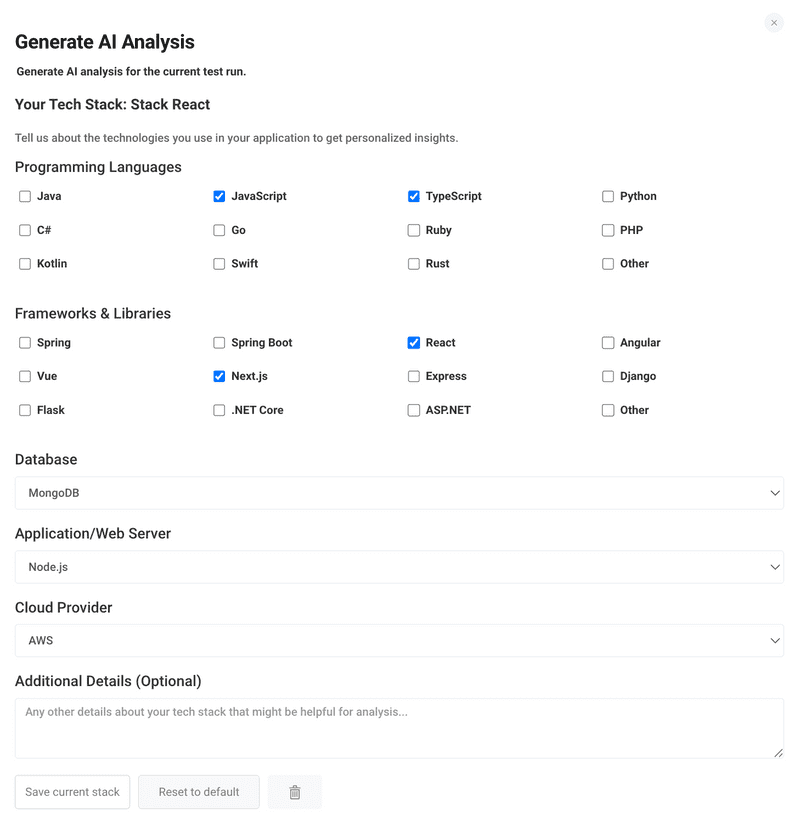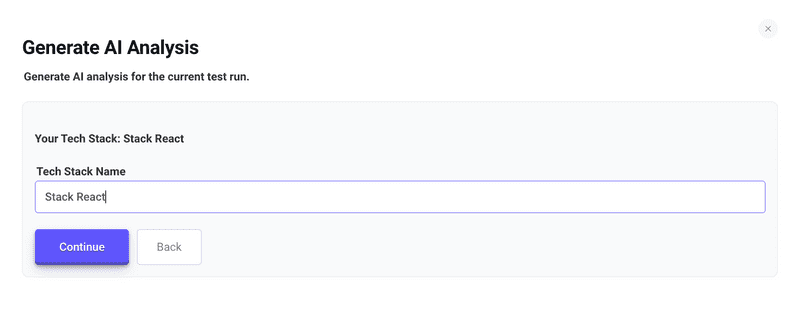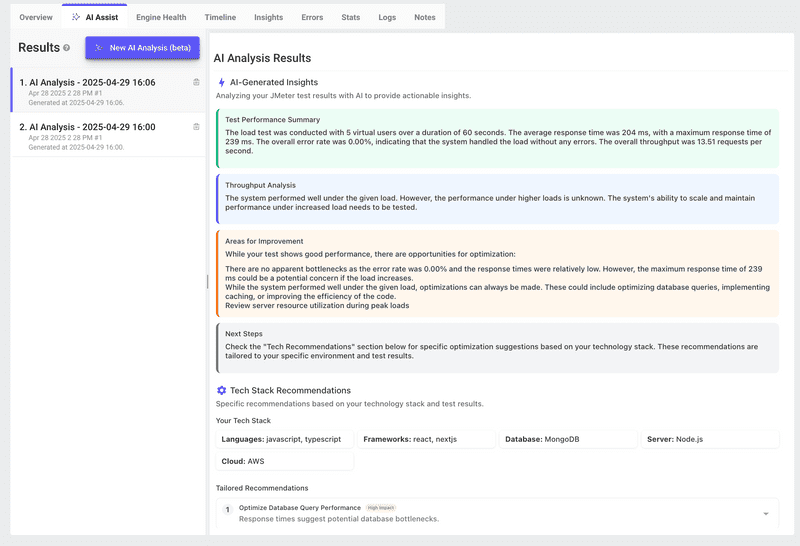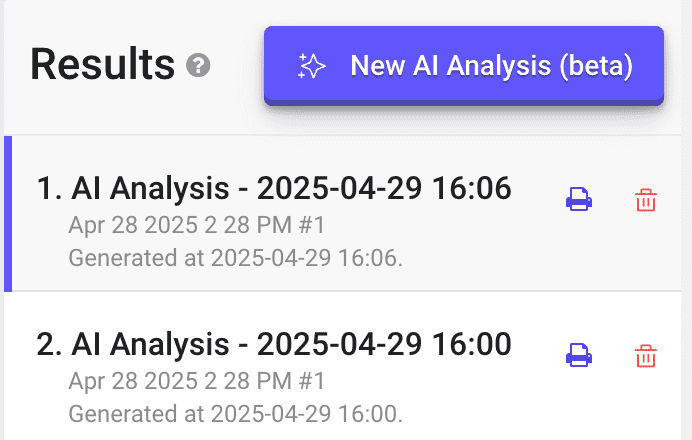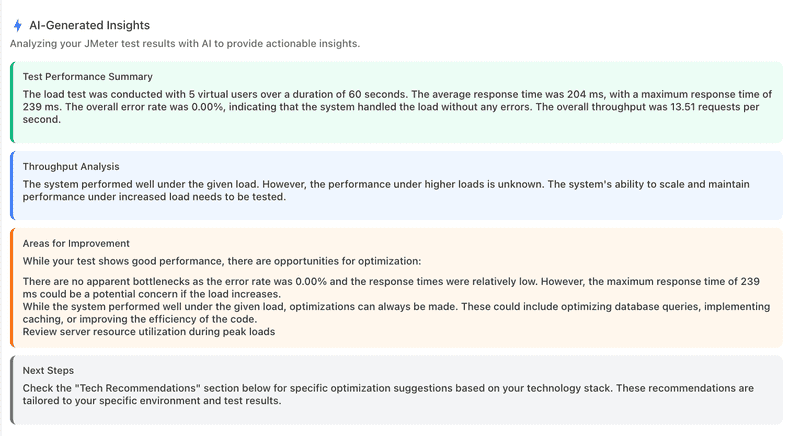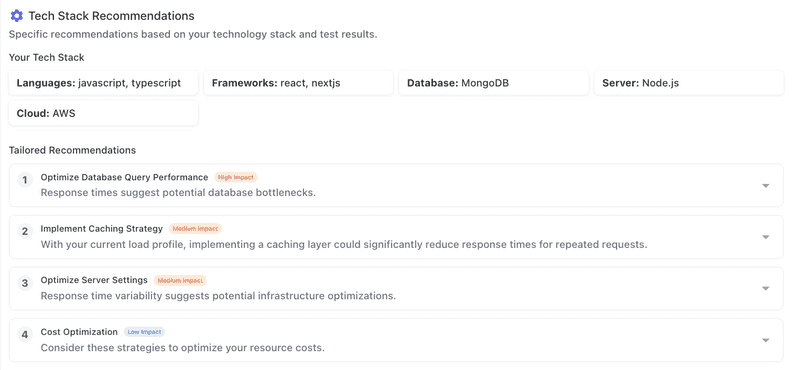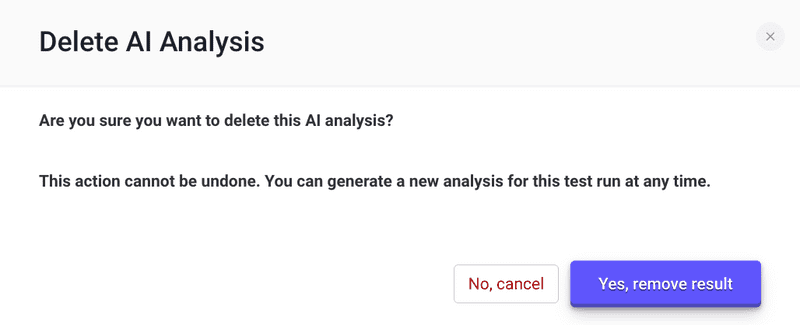Load Testing Results AI Analysis
Overview of AI Analysis
The Load Testing Results AI Analysis feature leverages artificial intelligence to interpret your performance test results and provide actionable insights. By defining your technology stack, you receive both a high-level summary of test performance and tech-specific recommendations to optimize your application. Works for both LoadFocus native load tests and Apache JMeter load testing.
What is Load Testing Results AI Analysis?
AI Analysis examines key metrics—such as response times, error rates, and throughput—from your LoadFocus or JMeter test run, automatically identifying potential bottlenecks and areas for improvement. Additionally, it tailors suggestions based on your selected tech stack, ensuring recommendations are relevant to your environment.
How to Access AI Analysis
- Open the AI Assist Tab Navigate to your test result dashboard and click the AI Assist tab.
- Start a New Analysis Click New AI Analysis (beta) to begin generating insights for the current test run.
Selecting or Creating Your Tech Stack
Before analysis, specify the technologies used in your application. You can either choose a previously saved tech stack or define a new one.
| Use Saved Tech Stack | Create New Tech Stack |
|---|---|
| Select from your saved configurations to re-use | Define languages, frameworks, database, server, and cloud |
Creating a New Tech Stack
If you opt to define a new stack, provide a name and select your technologies in each category:
- Programming Languages (e.g., JavaScript, TypeScript)
- Frameworks & Libraries (e.g., React, Next.js)
- Database (e.g., MongoDB, PostgreSQL)
- Application/Web Server (e.g., Node.js, Tomcat)
- Cloud Provider (e.g., AWS, Azure)
- Additional Details (optional notes)
Naming Your Tech Stack
Give your stack a descriptive name so you can easily re-use it later.
Generating the AI Analysis
Once your tech stack is selected or created, click Continue to have LoadFocus process your test data.
You’ll see a list of generated analyses. Each entry shows:
- A timestamp and run details
- A Print icon to generate a PDF of the report
- A Trash icon to delete the analysis
Printing an AI Analysis
To print or save a PDF of an AI Analysis report:
- Locate the analysis entry in the list.
- Click the Print icon
 .
. - Your browser’s print dialog will appear—choose Save as PDF or your physical printer.
Viewing AI-Generated Insights
Select an analysis from the list to view:
- Test Performance Summary highlights average, maximum response times, error rate, and throughput.
- Throughput Analysis evaluates how your system performed under the given load.
- Areas for Improvement points out potential bottlenecks or risks.
- Next Steps recommends further actions or tests to run.
Tech Stack Recommendations
Below your insights, the Tech Stack Recommendations section surfaces tailored optimization tips.
- Your Tech Stack shows the selected technologies as badges.
- Tailored Recommendations lists prioritized actions with impact levels (High, Medium, Low).
Example Recommendations
Optimize Database Query Performance (High Impact) Given your stack of JavaScript, TypeScript, React, Next.js, MongoDB, Node.js, and AWS, consider optimizing MongoDB indexes, leveraging Next.js server-side rendering, and tuning AWS RDS configurations.
Implement Caching Strategy (Medium Impact) Add a caching layer (e.g., Redis or CloudFront) to reduce repeated request latency as your load grows.
Auto-Scaling Infrastructure (Medium Impact) Configure AWS Auto Scaling groups to adjust compute resources dynamically based on traffic.
Serverless Cost Optimization (Low Impact) Explore AWS Lambda or Fargate to pay only for consumed compute time and simplify scaling.
Deleting or Regenerating an Analysis
If you need to remove an AI analysis, click the trash icon next to the entry and confirm deletion.
Note: Deletion is permanent, but you can always generate a new analysis for the same test run.
Conclusion
Load Testing Results AI Analysis accelerates performance tuning by combining automated insights with tech-specific recommendations. Define your stack once, and leverage AI-driven guidance to keep your application running smoothly under load.

